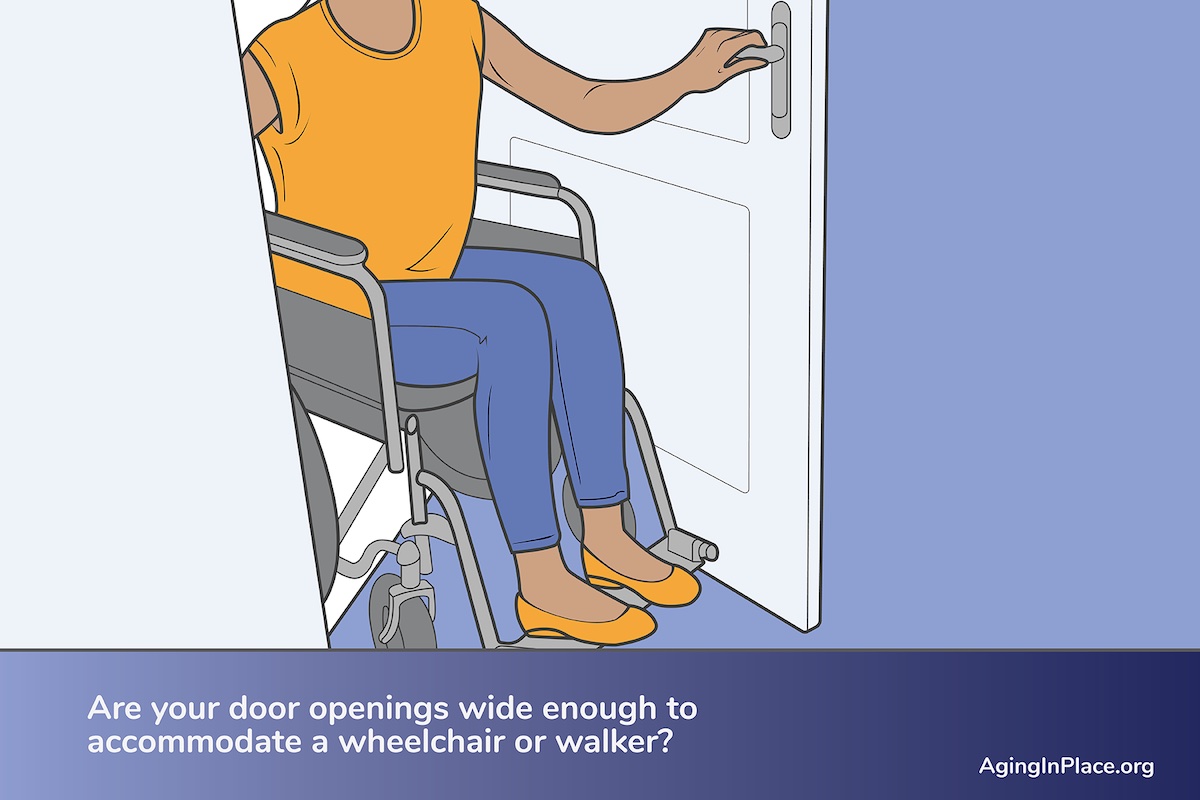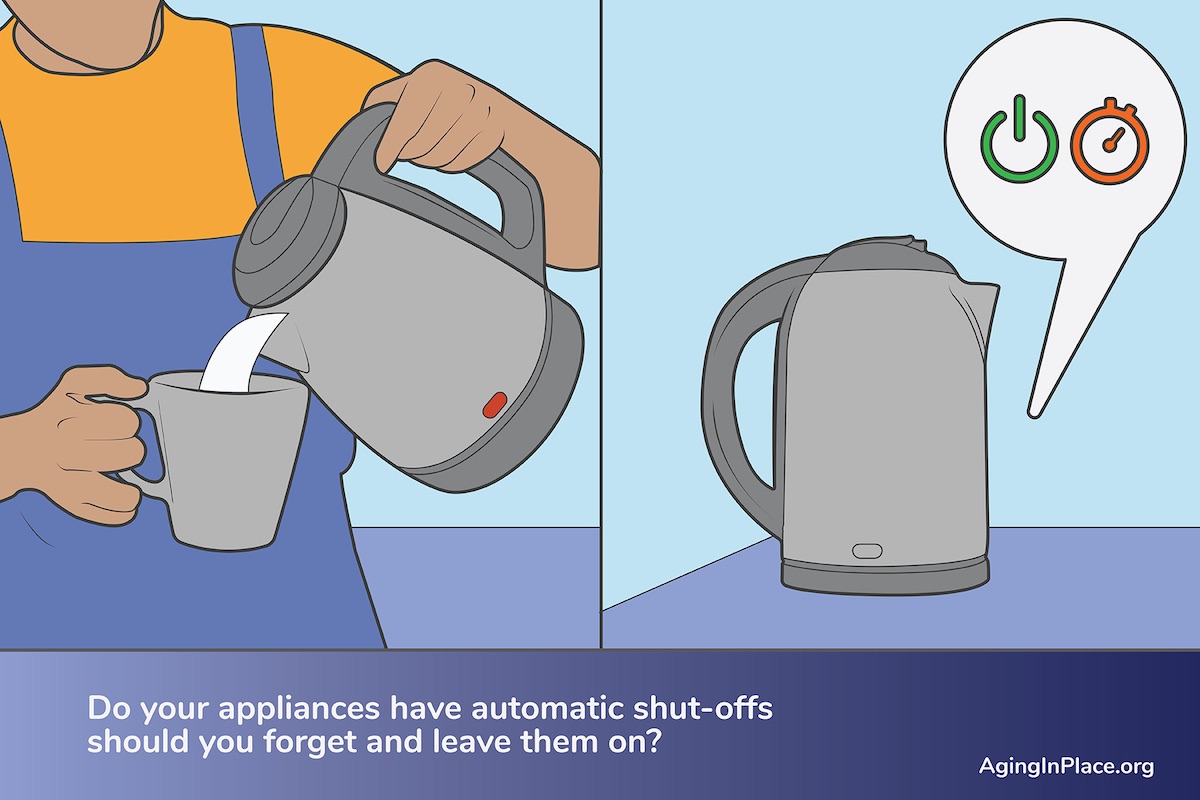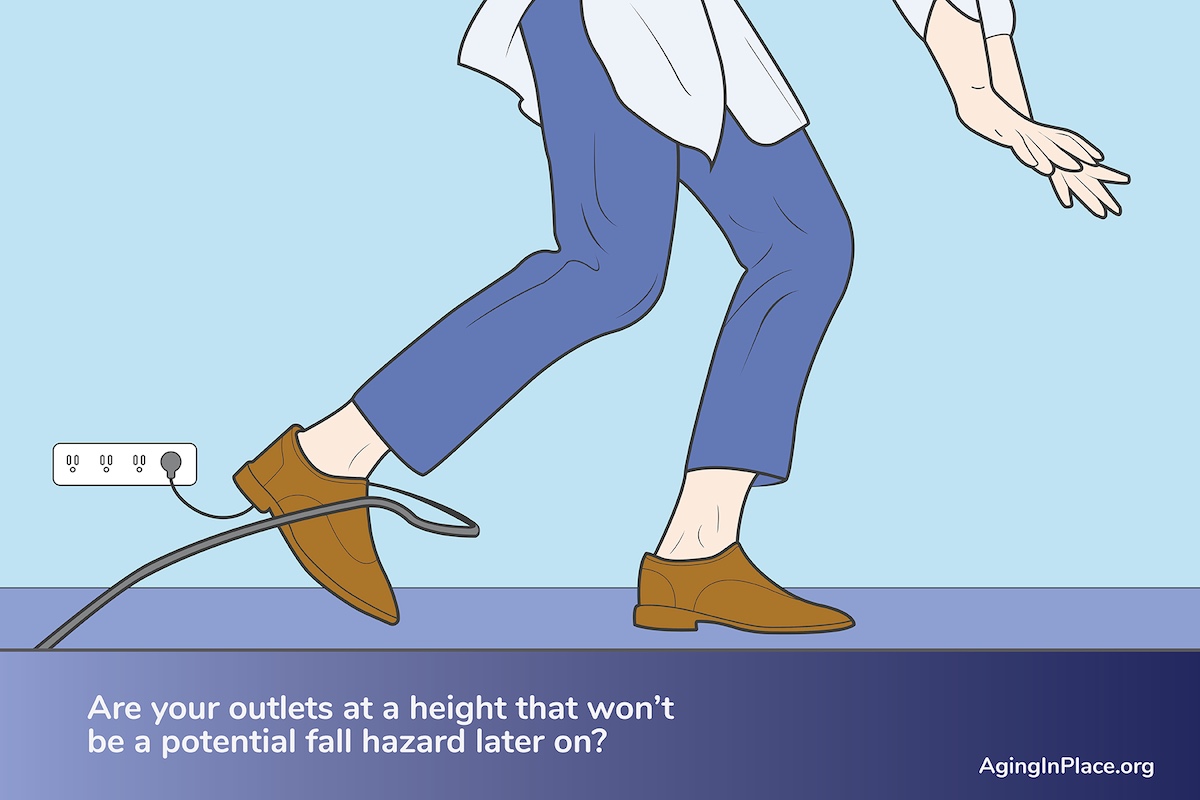A Guide to Home Modifications to Age in Place
The prospect of getting older brings with it new terrain: retirement and preparing for your financial future, a health plan, and—perhaps most importantly—where you’re going to live. If you intend to remain in your current home, having a plan regarding home modifications for aging in place is key—and it’s never too early to start.
“By accepting reality, learning what to expect as you age and how you can adapt to your ‘new normal,’ you can have a life where your activities and health care are in sync with what really matters to you.”
explains Dr. Rosanne M. Leipzig, professor of Geriatrics and Palliative Medicine at the Icahn School of Medicine at Mount Sinai Evaluate Your Living Space
According to a study published by the Journal of Housing for the Elderly, aging in place is “a continuous dynamic interaction as both the person and the environment change.” It’s vital that adults can perform activities of daily living (ADLs)—which include eating, using the toilet and bathing—in order to live independently, and these home modifications will help.
Evaluate Your Living Space
Before taking a sledgehammer to your house, evaluating your current living situation and identifying areas of improvement is the first step.
“The home that worked for you when you were 60 may not work when you’re 80,” says Dr. Leipzig, who authored the upcoming book Honest Aging about taking control of your health and well-being. “If you injure yourself while living alone, it could be days before someone finds you. If your memory is slipping, you could accidentally leave the oven on or the door to your home open. Is this a home where you can age in place?”
A few things you may look for as you evaluate your current living space:
- Are your primary suite or living quarters and kitchen on the ground floor?
- Can you move freely about your house without the use of stairs?
- If your home does have stairs, can they easily be replaced with ramps?
- Are your door openings wide enough to accommodate a wheelchair or walker?
- Do your appliances have automatic shut-offs should you forget and leave them on?
- Are your outlets at a height that won’t be a potential fall hazard later on?
- Is your home well-lit, and is there adequate contrast between countertop surfaces and the floors?
Seeing where you’re going to make home modifications will help with the big picture and assist you in mapping out a home renovation budget. Maybe your home already has an open floor plan and flexible design and only requires some small tweaks to make it friendly for aging in place. Or perhaps it’s going to need a complete overhaul, in which case you may need to plan further out for labor and supplies, as well as find a place to live in the interim while your home becomes a temporary construction zone.
Prioritize Function and Safety
In the past you might have made certain home modifications for style purposes, but when thinking about aging in your current home, keeping safety at the forefront of your mind should be a top priority. Having most of your rooms on the top floor of a multi-story home, for example, can be potentially dangerous as there may come a time when you need a cane, walker, or wheelchair—none of which are stairs-friendly—in order to get around.
If you’re considering moving homes at some point in the future, Owen O’Neill recommends buying a one-story house, as it will help make it easier to move around as you age, says the CEO of Clinics Can Help, a nonprofit that collects and donates medical equipment and supplies that are in good condition. If the home does have stairs and the individual might need a wheelchair or walker, O’Neill suggests constructing and installing ramps to ensure both mobility and comfort. Though pricier than a ramp, a chair lift is another option for a home with difficult stairs.
Follow ADA Standards for Accessible Design
“Going up and down flights of stairs and traversing narrow passageways can be hard, especially if your mobility is limited,” Dr. Leipzig says.
Using the ADA Standards for Accessible Design as your road map for home modifications will help address mobility issues as you age in place safely. This includes having a clear path to travel from room to room via continuous, unobstructive pathways (no protruding objects or variations in floor height) and widened doorways (minimum 32 inches) through which wheelchairs can easily pass. If your home has stairs at any entrance, you may also want to go ahead and install a ramp now.

Incorporate Necessary Durable Medical Equipment
Many aging adults will eventually need durable medical equipment (DME), which can range from wheelchairs and scooters to hospital beds and patient lifts. Medicare and many insurance plans often cover the majority of medically-necessary costs. O’Neill says that while it’s important to have the right DME in place, you should purchase only medical equipment that is recommended by your physician or medical therapist. “This will help ensure [DME] is used properly and that any home modifications can be explained [to insurance] when the piece is acquired,” he says. He also suggests checking to be sure the equipment has not been recalled before purchasing any DME.
Maximize Lighting Options
According to a study published in the Journal of Multidisciplinary Healthcare, vision is essential in promoting healthy aging at home, and this requires adequate lighting solutions. The American Optometric Association (AOA) reports that many adults experience problems seeing clearly at close distances as early as their 40s; this loss of vision is accentuated when reading and working on the computer and will continue to progress with age. Since older adults also frequently have issues with contrast sensitivity and color discrimination, properly lighting the home for everyday tasks, like cooking and reading, is necessary.

The Journal of Multidisciplinary Healthcare study found that good lighting not only improved the ability to read, but it also enabled higher performance of activities of daily living (ADLs) while simultaneously improving the home environment. Simply adding task lighting around the house or LED under-the-counter strips in the kitchen can make all the difference in increasing visibility in a home without adequate light.
Invest in a Medical Alert System
Living alone can be daunting—it can also be dangerous if balance is an issue. With a medical alert system [MAS] on hand, you have the capability of immediately notifying medical professionals should you fall or need help quickly. According to the Centers for Disease Control and Prevention (CDC), more than one out of four people aged 65 and up falls each year—and falling once doubles your chances of falling again. MAS equipment doesn’t just summon medical responders, but many of them will alert your family members or caregivers as well. Some systems also monitor the immediate environment for smoke, fire, or elevated carbon monoxide levels.
Start with the Rooms You Use the Most
When planning your home modifications for aging in place, it’s a natural progression to start with the most-utilized rooms. For most people, this is the bathroom and kitchen: two spaces in which you likely spend the majority of your days. Once you have those areas planned and adequately equipped, it will give you a better idea of what you need to do in your bedroom and living area, like installing handrails or improving lighting.
The Bathroom
Bathrooms and showers can be especially difficult to navigate, Dr. Leipzig says, so when it’s time to redo your bathroom, planning for the future is always wise—even if you don’t need safety functions like a handrail just yet. It’s easier to install ADA-compliant features when renovating now versus down the line when you need it immediately. And if you live in a multi-level home with the bathrooms upstairs, finding a way to install a bathroom on the main floor is critical.
Slipping is always a top concern when bathing, particularly as you age and your balance becomes more precarious. You could consider installing a walk-in tub in place of a step-in tub. Consider installing a non-slip chair (if room allows) in either type of tub. If you only have a stand-up shower, then consider installing a non-slip chair. Whether you have a shower or tub, there should be a non-slip mat or surface. And install handrails in both.
Leaning over to access a toilet or tub can also be a hazard, so O’Neill suggests installing safety rails near any tub, shower, and toilet, as well as installing grab bars in the shower and around the toilet seat, as “they provide stability and are an added source of safety should a person have any physical challenges.” Having something to hold onto as you move throughout your bathroom will give you added insurance against falling, and installing a raised toilet seat will also decrease the possibility of falling.
Other simple and cost-effective ways to make your bathroom more aging-friendly include installing non-slip bath mats with rubber backings and non-skid rubber mats or strips in the tub. Dr. Leipzig recommends lowering the bathroom water thermostat to 120 degrees Fahrenheit. Most thermostats are automatically set to 140 degrees, which can be a scalding hazard for some seniors with sight and/or mobility issues.
The Kitchen
A kitchen remodel is often among the pricier home renovation projects, but there are certain components you need to consider as you age. Flooring is a top concern, particularly for those with lower back or hip pain. Having harder tiling in your kitchen can not only be tough on the body if standing for long periods, but it can also create tripping hazards if you have deep grout lines or chipped and uneven tiles. If you’re already remodeling, choosing cork flooring, hardwood, luxury vinyl tiles, or vinyl are all solid flooring options for aging in place; however, if you’re working with a more limited budget, you can buy anti-fatigue mats that are extra squishy so as to be kind to your knees and feet, while also preventing further stress on your joints.
Many kitchens utilize darker stones for countertops, but colors like black granite can be hard to visually delineate as your vision declines. Instead, consider a lighter countertop so that you don’t have to worry about running into sharp edges because you didn’t see them. Using lighter colors will also help you spot spills as they occur (and possibly prevent you from slipping and falling).
Other small changes, like installing wall outlets beneath cabinets or within a backsplash, can make all the difference later, as they’ll reduce the need for leaning over and possibly causing a fall. Dr. Leipzig says that as people naturally shrink with age, reorganizing the kitchen and closet by moving objects from high shelves and bringing them to a more reach-able location is a wise move to make right now.
Have a Support Plan Mapped Out
As you make home modifications, it’s also vital that you consider how you will be able to have your everyday needs taken care of if you’re less mobile, unable to drive, or having some memory problems, according to Dr. Leipzig. “The neighborhood may have changed, with neighbors, friends, and community connections no longer there,” she explains. “Public transportation may be limited. If it exists, it may be hard to access, requiring the use of stairs or a working elevator.”
“Age-related declines in capabilities may compromise older adults’ ability to maintain their homes thus threatening successful aging in place,” Journal of Housing for the Elderly reports in its study Challenges to Aging in Place: Understanding Home Maintenance Difficulties. For example, getting on all fours to scrub baseboards and remove grime might not be as easy as it once was.
In fact, nearly 70 percent of participants from Elderly’s study reported that the most difficult home maintenance tasks were either cleaning or outdoors related. Such chores include tasks like vacuuming, changing bed linens, washing dishes, doing laundry, taking out the garbage and mowing the lawn. Having both a cleaning and lawn service scheduled a couple times a month will help ease this burden, as will having a maintenance company or handyman on call for when the need arises. You’ll also want to make sure you have a system in place for checking on your overall well-being.
“Work out a system so that a friend, family member, or local community agency calls you daily to check in,” Dr. Leipzig says. “You could make this a buddy system with a friend. Give them a key, or make sure they know whom to contact to enter the home if you don’t answer the phone.”
Many community organizations, senior centers, and local churches and nonprofits offer handy resources that can help alleviate your biggest fears of aging in place. In addition to activities and clubs, many of these organizations provide local transportation, which will give you peace of mind that you won’t have to drive should your vision decline over time. Also, researching your closest Meals on Wheels program or learning how to use mobile delivery and grocery services now will help make access to food easier later on.

Learn How to Use Technology
Acing technology can be challenging for any generation, particularly with how quickly the home-tech market advances (think: heating and cooling operated by an app, lights programmed on a timer), but the more you can learn how to use it now, the better off you’ll be down the road.
Especially as one UC San Diego study shows that technological advances “have been shown to have great potential in fostering independent living, improving mental and physical health, and increasing quality of life.”
Learning new technology could be as easy as having a child, grandchild, or neighbor give you free tutorials on how to use your phone, computer, and other home devices. Community agencies and senior centers often have free classes on how to use the computer and access the internet, Dr. Leipzig adds. “Once you’ve learned this technology, you can use video to connect with loved ones, take classes online, and participate in book groups, current event discussions, or other activities offered by community agencies.”

Don’t Gloss Over the Minor Details
While bigger home modifications may seem overwhelming at times, there are small changes you can make now that will help you age in place in the future. Dr. Leipzig recommends using pill organizers or blister packs to help manage medication, setting up an automatic bill-paying service through your bank or another online system, and getting familiar with the transportation options available in your area.
“If you have difficulty using your hands or dressing, work with an occupational therapist who can identify specific tools that may help you do the things you’re having difficulty with,” Dr. Leipzig says. “Utilize adaptive devices like grabbers or telescoping reachers to help access high or low objects.”
Removing throw rugs and clutter from the floor and stairs, and making sure there are no power cords in places that you might trip over, are other minor home modifications Dr. Leipzig suggests every older adult should make.
“As you age, learn what to expect and what you can do to optimize your ‘new normal,’” Dr. Leipzig concludes. “Never say never. Be creative—and remember that the goal is an engaged and meaningful life.”
WRITTEN BY
Kristin Luna has a bachelor’s degree in journalism and electronic media from the University of Tennessee and has worked as a journalist for the past 20 years. An expert in home renovation, she widely covers all aspects of home improvement, including what it takes for aging homeowners to live comfortably and sustainably. She also runs a public art nonprofit, DMA-events, dedicated to providing free and accessible art to all populations.
